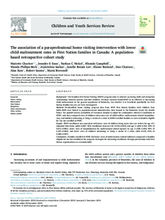Abstract
Background
The Families First Home Visiting (FFHV) program aims to enhance parenting skills and strengthen relationships between parents and their children. Previous research found FFHV to be effective at decreasing child maltreatment in the general population of Manitoba, but whether it is beneficial specifically for First Nation families has not yet been investigated.
Methods
De-identified home visiting program data from 4010 First Nation families with children born 2003–2009 were linked to population-based administrative data housed at the Manitoba Centre for Health Policy. We applied inverse probability of treatment weights to adjust for confounders related to enrollment in FFHV, and then compared rates of children taken into care of child welfare, maltreatment-related hospitalization, and children witnessing or being a victim of a crime in FFHV-enrolled families to rates in families eligible for but not enrolled in FFHV.
Results
FFHV enrollment was associated with lower rates of children being taken into care before the age of 1 (adjusted Risk Ratio [aRR] 0.687; 95% Confidence Interval [CI] 0.576–0.819) and age 2 (aRR 0.763; 95% CI 0.611–0.881), lower rates of hospitalization for maltreatment-related injuries by age 3 (aRR 0.429; 95% CI 0.187–0.983), and lower rates of children witnessing or being a victim of a crime (aRR 0.591; 95% CI 0.385–0.907).
Conclusions
Families enrolled in FFHV had lower rates of maltreatment-related indicators compared to families eligible for but not enrolled in the program. Strategies for increasing enrollment through partnerships with First Nation organizations are recommended.

